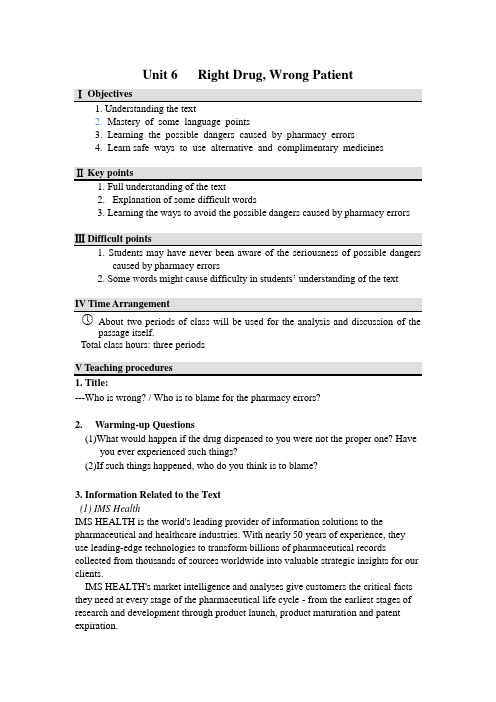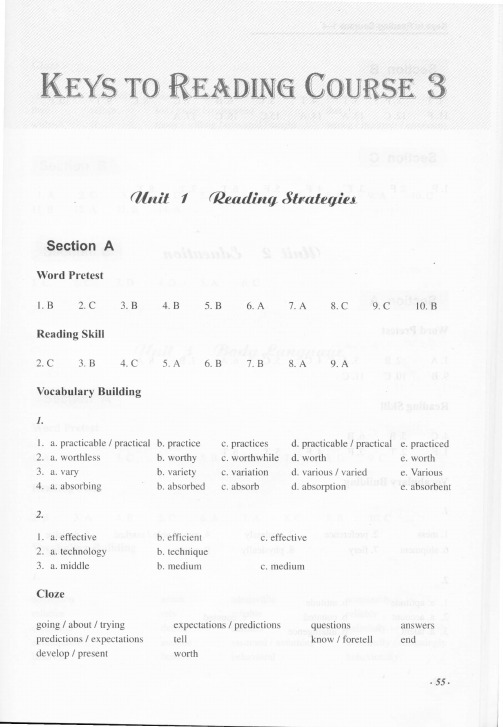大学英语泛读教程3(第三版)课件Unit 6
《泛读教程》_第三册(Unit1~Unit10)

《泛读教程》第三册王守仁(Unit1~Unit10) 参考答案Unit 1Section AWord PretestBCBBBAACCBReading SkillCBCABBAAVocabulary Building1 practicable practice practices practical practiced2worthless worthy worthwhile worth worth3vary variety variation various various4absorbing absorbed absorb absorption absorbent21effective efficient effective2technology technique3middle medium mediumClozegoing expectations questions answers predictions tell know end develop worthSection BTFTT CBCC TFF CAACCASection CFFTFFTTTUnit 2Section AWord PretestABACCABABCCReading SkillCBB FTFFTTVocabulary Building11mess 2preference 3aimlessly 4remarkable 5decisive 6shipment 7fiery 8physically 9action 10housing21aptitude attitude2account counted counted3talent intelligenceClozeother just has some than refuse see that without if ready wrongSection BACCCCCCCACBABASection CCCDDACUnit 3Section AWord PretestABCCBDCDCReading SkillBABCAACBCVocabulary Building1Admission admit admissible admissiblyReliance rely reliable reliablyDefinition define definite definitelyAssumption assume assumed assumedlyBehavior behave behavioral behaviorallyVariety vary various variouslyPart part partial partiallyManager manage managerial manageriallyCorrelation correlate correlative correlativelyAdaptation adapt adaptive adaptively21inspired aspired inspired2token badges token3contemporaries temporary contemporaryClozeCommunicate ways using in of message meet causes meaning to eyesSection BBABBAC FFTTTF CCBSection CBBDDBCCA FFTFFTUnit 4Section AWord PretestCACAABBBCCReading SkillBBACBCCAAVocabulary Building11moist 2betrayal 3exclusively 4inhumane 5amazed 6endangered 7marvels 8deadly21dessert deserted2favourite favorable favorable3awarded reward awardedClozeParents idea at seen landmarks instance migrate guide pole effect it if experimentsSection BCCB FTF BCACCBACCSection CFFTFFFTTFTUnit 5Section AWord PretestCAABCACCCReading SkillCABCB FFTFTTVocabulary Building1Assumption assume assumed assumedly Acknowledgement acknowledge acknowledgedly Reflection reflect reflective reflectively Domination dominate dominant dominantly Category categorize categorical categoricallyImplication imply implicative implicativelyReassurance reassure reassuring reassuringlyDefinition define definite definitely21historical historic2rejected resist3test analyzedClozeExisted over head body found language use single passed ahead survival handlingSection BCABCBB TTTFTT CACSection CBBAAACBCUnit 6Section AWord PretestC ACBABACABABReading SkillCAACACCAVocabulary BuildingAvailability avail available availablyConquest conquer conquering conqueringlyLuxury luxuriate luxurious luxuriouslyOrgin orginate original originallyOccurrence occur occurrentSystem systematize systematical systematicallyPhonology (这个是没有动词形式的)phonological phonologicallyDecision decide decided decidedlyVariety vary various variouslySuperiority (这个是没有动词形式的)superior superiorlyPeculiar particular particularAssess access accessResources source sourcesClozeSex men differs compliment complimenting causes makes languages have outside understood have use circleSection BCBBBACBCCCCBACCBASection CBBCABBACCBUnit 7Section AWord PretestABABCBACReading SkillBBBCCBCBVocabulary BuildingDeduced behavior adhere replacement option delicacy enormous pursuitInquired required inquire requiredCompatible comparable compatible comparableClozeSatellite some space asked life sort orbiting have living were believe own solar where likely living throughSection BFTFFTTTTTFFFBBCACCSection CBCBCCAEDEBAFDCUnit 8Section AWord PretestBCABCBBCCAReading SkillCBABCBCCCCVocabulary BuildingOccupation occupy occupational occupationallySegregation segregate segregated(这个没有副词)Discrimination discriminate discriminating discriminatingly Enforcement enforce enforceable enforceablyExclusion exclude exclusive exclusivelyPerseverance persevere persevering perseveringlyConviction convict convictive convectivelyAmendment amend amendable(这个没有副词)Superficiality superficialize superficial superficially Spectator spectate spectatorial (这个没有副词)Job career jobs careerPrincipal principles principal principleFeminine female feminineClozeAcceptable domestic property wages husband divorce claims legal suit permitted make excluded lacked belonged determined Section BBACCCCACCCAABBACTTFSection CCCAACBUnit 9Section AWord PretestBAABCACBBABCReading SkillCACCBBBBBACBVocabulary BuildingTypifies dominant familial competitive vibrate descended departure boom countless symbolizesRecreation recreates recreationRhythm rhyme rhymes rhythmClozeSea within of divides built celebrated inside attract together whenSection BFTFTTCCBBCBAACCACSection CBAACABCCCCUnit 10Section AWord PretestCABCBBBBABReading SkillCBCACCCABBVocabulary BuildingConsequence(这个没有动词形式)consequent consequently Sophistication sophisticate sophisticated sophisticatedly Reference refer referable referablyConversation converse conversational conversationally Space space spatial spatiallyDetachment detach detachable detachablyIntervention intervene intervening(这个没有副词)Type typify typical typicallyAssure ensure assured ensureArises raised rise raised arisenClue cues clue cueClozeWell separating is own close need look order respect follow prior sign help was elseSection BBBCTTFBCACACTFFSection CTFFTFFFF。
英语泛读3unit6RightDrug

Right Drug, Wrong Patient 药对了,病人错了(Andrea Rock 安德里亚·洛克)摘自:英语泛读教程四As a rule, the pharmacy's proficiency and authority is little doubted. But the rate of pharmacy errors is much higher than people think. Imagine what would happen if the drug dispensed to you were not the proper one. The following article tells us more about pharmacy errors.通常,药房的职业水平和权威是很少受到怀疑的。
然而,药房的出错率比人们所想的要高得多。
想一想,要是药房给你开错了药会出现什么后果?下面这篇文章将会告诉我们更多有关药房错误的事情。
At breakfast, seven-year-old Gabrielle Hundley took the first of two pills that would change her life. The new prescription that her mother, Peggie, had gotten filled at the Rite Aid in Rock Hill, S.C., was for Ritalin, a drug used to treat attention deficit- hyperactivity disorder.在吃早餐时,7岁的加布里埃尔·亨德黎服下了将会改变她一生的两粒药中的第一粒。
新处方上开的药是利他林,这是她母亲佩吉在南卡罗来纳州洛克山的日特爱德药店配的药,一种用来治疗注意力缺失/过动症的药。
英语泛读教程3第三版 课文翻译(Text1--1-7单元)

UNIT 1 创造性思维的艺术约翰·阿代尔创造性对人类发展至美重要。
下面的文章里,约翰·阿代尔为求实的创造性思维者提供了一些颇有见地的见解和技巧。
创造性思维在今天的重要性不需要强调。
在你的职业中或工作领域,如果你能够发展提出新思想的能力,你就有竞争优势。
在你的个人生活中,创造性思维也能将你带上创新活动之路。
它可以丰富你的人生,尽管并非总是以你期待的方式。
人类创造力人类不可能凭空创造东西。
有一次,一位来宾极为仔细地参观了亨利·福特的汽车公司,然后见到了福特。
来宾心中充满了惊奇和崇敬,他对这位实业家说:“福特先生,25年前起家时几乎一无所有的人,不可能实现这一切。
”福特回答说,“这个说法可不太对。
每个人都是靠所有拥有的东西来起家。
这里什么都有——所需要的一切,它们的基本点和实质性的东西都已存在。
”潜在的材料,也就是可以做成或建构成某种东西的元素之成分或者实质的材料,都已存在于我们的宇宙。
你可能已经注意到,我们倾向于将创造性这个词用在与使用的原材料很不一样的产品上。
鲁宾斯的一幅名作,就是蓝色、红色、黄色和绿色的蠕虫般颜料在艺术家画板上的集合。
物质材料,对艺术家来说是颜料和画布;对作家来说是纸和笔——完全是次要的。
这里的创造,更多的是在大脑之中。
感知、思想和感觉都在一种观念或想象中结合起来。
当然,艺术家、作家或作曲家还需要使用技巧和技术,在画布或纸上把头脑中构想出来的东西塑造成型。
和普通意义上的创造性一样,创造性思维遵循同样的原则。
我们的创造性想象必须有可以加工的对象。
我们不能凭空产生新的思想。
如上面福特所说的那样,原材料都在那里。
有创造力的大脑在原材料中看到可能性和相关性,而创造力不强的大脑却看不到。
这一结论让我们大大地松了一口气。
你不用凭空构想新的想法。
作为创造性思维者,你的任务是将已经存在的想法或元素组合在一起。
如果最终把人们从未想过可以联系起来的想法或事物,用看似不可能却很有价值的方式组合起来,那人们就会认为你是创造性思维者。
大学体验英语综合教程3[第三版]Unit6PPT课件
![大学体验英语综合教程3[第三版]Unit6PPT课件](https://img.taocdn.com/s3/m/f118513a783e0912a2162a95.png)
She knows every nook and cranny in and around Cairo — no easy feat. Cairo with its complex system of streets and lanes, its quarters and markets is like a labyrinth invented by ancient storytellers. Hundreds of mosques — many of which are masterpieces of Islamic architecture, old neighborhoods with houses boxed together, huge apartment buildings on the outskirts and the Nile calmly running through it; all are part of this overcrowded city.
I feel a firm hand holding my left arm. “You want taxi, follow me,” the woman says. She doesn’t ask, she simply pulls me through the crowd. I follow her willingly. There is this moment when a tourist, particularly a woman, simply has to trust someone. We stop at a worn car. It has seen a better day, there are quite a few scrapes on its body, the tires are bald and there is a crack in the windshield. But it is a car for hire, and the woman will personally drive me. I breathe a sigh of relief when she puts my bag into the trunk, locks it and gets behind the wheel. “I will drive you, don’t worry,” she says.
unit6 英语泛读教程第三册

Unit 6 Right Drug, Wrong Patient2. Mastery of some language points3. Learning the possible dangers caused by pharmacy errors4. Learn safe ways to use alternative and complimentary medicines2.Explanation of some difficult words3. Learning the ways to avoid the possible dangers caused by pharmacy errorscaused by pharmacy errors2.Some words might cause difficulty in students’ understanding of the textAbout two periods of class will be used for the analysis and discussion of the passage itself.Total class hours: three periods1. Title:---Who is wrong? / Who is to blame for the pharmacy errors?2. Warming-up Questions(1)What would happen if the drug dispensed to you were not the proper one? Haveyou ever experienced such things?(2)If such things happened, who do you think is to blame?3. Information Related to the Text(1) IMS HealthIMS HEALTH is the world's leading provider of information solutions to the pharmaceutical and healthcare industries. With nearly 50 years of experience, they use leading-edge technologies to transform billions of pharmaceutical records collected from thousands of sources worldwide into valuable strategic insights for our clients.IMS HEALTH's market intelligence and analyses give customers the critical facts they need at every stage of the pharmaceutical life cycle - from the earliest stages of research and development through product launch, product maturation and patent expiration.With more than 5,000 professionals in 100 countries - from Austria to Australia - from China to Costa Rica - from Saudi Arabia to Senegal - IMS HEALTH is a trusted healthcare-industry strategic partner, with thousands of customers and annual revenue in 2001 of $1.3 billion.(2) U. S. PharmacopeiaIn pursuit of its mission to promote public health, USP establishes state-of-the-art standards to ensure the quality of medicines for human and veterinary use. USP also develops authoritative information about the appropriate use of medicines. National health care practitioner reporting programs support USP's standards and information programs. In addition, USP supports many public service programs.(3) Careers in medicine in the USTo become a medical doctor in the US, one must attend four years of college and receive a bachelor’s degree, followed by four years of medical school. Then he becomes an intern in a hospital and receives supervised practical training. As an intern, he has to “make rounds” with other doctors, visiting hospital patients. He is supposed to help give special treatments and answer emergency calls in the hopital at any time of day or night. Finally he becomes a resident at a hospital. Like the intern, he learns by observing the work of others. But the resident has much more responsibility than the intern. He often assists experienced surgeons during operations. In an emergency, he may take over the work of the staff surgeon.Internship and residency combined take three to five years, depending on one’s area of specialization. Hospitals have several interns and many residents on their staff. A resident who is completing his residency period and who thereby distinguished himself is selected to be chief resident, a position of greater responsibility.(4) Three types of doctors1. General practitioners 全科医生2. Specialists3. Researchers4. Text analysis(1)Article Abstract:Drug-dispensing errors are a common occurrence, requiring customers to be vigilant when having their prescriptions filled at pharmacies. These errors are attributed to understaffing and the consequent increase in workloads in the retail drug industry, coupled with rising prescription volume. Tips on how one's family can be protected from pharmacy errors are presented.(4)passage divisionPart I (para.1-8) By giving examples and providing statistics, the author pointout the seriousness of the drug dispensing errors.Part I (para.9-31) Some ways on how to protect you family and yourself.5. Key words and phrases(1) pharmacy error/drug dispensing error(2) prescription(3) dose(4) awry(5) churn out(6) be attributed to(7) fatal (8)medical vendor(9) submit to(10) oversight(11) counsel(12) pharmacist(13) adverse effect(14) dearth6. Language Notes1. The new prescription that her mother, Peggie, had gotten filled at the Rite Aid in Rock Hill, S.C., was for Ritalin, a drug used to treat attention deficit-hyperactivity disorder.(新处方上开的药是"利他林",这是她母亲佩吉在南卡罗来纳州洛克山的"莱特相助"药店配的药,一种用来治疗注意力亢奋/不足的药。
泛读教程第三册参考答案

.犭 F.
κ eys to Reading Cou阝
es1-4
∷ ∷ 蛳
∷ ,∷
8.C 9.C 10,C
1,C 2,B 3.B 4。 B 5。 A 6。 C .7.B 11.C 12,B 13.A 14.C 15.C 16.B 17.A
∷ ∷ ∷ ∷ 蛳
1.B 2.B
∷ ∷∷ ,∷
3.C 4.A 5。 B 6,B 7.A 8,C 9.C 10,B
1ifc .62.
some
sort/1ond
space
orbiting`going/circling
asked/wOndcred
have
Keys tO Reading Course3
Ⅱ ving
were
be1ieve
lⅡ
oWn
living
solar
through
where
cly
∷ ∷sectlm∷ B∷ ∷
3.B 13.A
4.F 14.C
5,T 15.C
6.F
7.B
8.C
9.A
10.C
疵矿t
`诋2.F 1.F
3.T
4.F
5.F
6.F
7.T
8.T
9.F
10.T
叼 臼 匕 饪
5
砀
∷ ∷ 蛳
1.C 2.A
∷ ∷ ∷∷
3,A
4.B 5.C
`∷ Word PⅡ etest 6.A
7.C 8.C
9.C
・ 59.
κ ysto Rmdino Coumes1-4 ●
_∷ ∷∷∷ △ ∷
6助山£ 昭
t〃
匍 纽 饧 哆岛 咧 锄 泗
英语泛读教程3__课文翻译

UNIT 1 新造词 (1)UNIT 2 英国人的谨慎和礼貌 (4)UNIT 3 打破魔术的气泡 (7)UNIT 4 寻找可以依靠的坚实臂膀 (8)UNIT 5 艰难登顶 (11)UNIT 6 药对了,病人错了 (14)UNIT 7自己的房间 (17)UNIT 8 反对吸烟的角色扮演 (18)UNIT 9 梦与睡眠一样重要吗? (21)UNIT 10 诚信原则 (24)UNIT 11 非言语交际 (27)UNIT 1新造词英语中每天都有新词出现。
你知道这些词是怎么产生的吗?阅读下文你就能找到造英语单词的各种方法。
学者们估计英语大约有600 000个单词,不过也许更多。
新的词语不断进入英语,其速度之快,大概没有一本字典能跟得上。
几个世纪以前,源于盎格鲁•撒克逊语、日尔曼语以及法语的原有词汇,占英语的五分之四。
余下的五分之一,一部分外来词组成,另外的部分由其它三种词组成,它们是:表示人名、地名的专有名词;象声词以及新造的词。
安培、伏特和瓦特都是电学的计量单位,它们都是用发现者的名字命名的,他们分别是是法国物理学家安德烈• M•安培、意大利物理学家阿勒森德罗•伏特、苏格兰工程师兼发明家詹姆士•瓦特。
今天我们都喝用巴氏灭菌法消毒的牛奶,这种奶即清又纯。
巴氏灭菌法便得名于法国医生路易斯•巴斯德,是他发明了消毒牛奶的制作方法。
在英语中像这样的词有许多象声词代表它们模仿的事物或行为的声音。
现举例如下:嗡嗡滴答砰砰咕哝喳喳嚎啕扑通啪啪嘀咕咯咯嘤嘤呼哧对于上述单词无需再作任何解释,因为它们不言自明。
或许你还可以想出更多类似的单词来。
接下来是新造的词。
讲英语的人总是根据需要创造词汇,而且每天仍在这样做。
一种新造的词是由另外两个词构成的。
字典里将这种词称为复合词。
如果把“玩耍”和“物品”放在一起,我们就可以得到复合词“玩具”。
你还能为下表添加多少类似的词呢?雨衣奶昔楼上停顿前灯关闭帆船楼下收入标题除了把两个词放在一起之外,我们还可以给单词添加一些成分,即前缀和后缀。
大学英语泛读教程3(第三版)课件Unit 6

A Do You Get It?
Multiple Matching
Reread the four passages (A-D) in the text.
Which of the four passages refers to … __B___ 1. extinct creatures? __C___ 2. two scientists? __B___ 3. written myths? __D___ 4. a survey? __C___ 5. an example? __C___ 6. an adaptation of a previous argument? __A___ 7. keeping children out of school? __B___ 8. marks caused by animals? __C___ 9. a comparison with a mechanical object? __B___ 10. a change of argument?
U6-p.61
Track 13
Complex Problem
A popular argument by people seeking to deny the validity of evolution is that humans are simply too complex to have evolved without some kind of creator lending a helping hand. This argument was first put forward in 1802 by the Christian philosopher William Paley, who used the analogy of a watchmaker. Something as complex as a watch, Paley argued, had to have a designer. A version of this idea was revived by creationists and is now referred to as the intelligent design argument. One proponent of this belief is the biochemist Michael Behe. In one of his books, Behe referred to the “irreducible complexity” of organisms like human beings. Such organisms are so sophisticated, the argument goes, that removing even one tiny element from them would cause them to malfunction.
- 1、下载文档前请自行甄别文档内容的完整性,平台不提供额外的编辑、内容补充、找答案等附加服务。
- 2、"仅部分预览"的文档,不可在线预览部分如存在完整性等问题,可反馈申请退款(可完整预览的文档不适用该条件!)。
- 3、如文档侵犯您的权益,请联系客服反馈,我们会尽快为您处理(人工客服工作时间:9:00-18:30)。
A Do You Get It?
Multiple Matching
Reread the four passages (A-D) in the text.
Which of the four passages refers to … __B___ 1. extinct creatures? __C___ 2. two scientists? __B___ 3. written myths? __D___ 4. a survey? __C___ 5. an example? __C___ 6. an adaptation of a previous argument? __A___ 7. keeping children out of school? __B___ 8. marks caused by animals? __C___ 9. a comparison with a mechanical object? __B___ 10. a change of argument?
U6-p.60
Reading
Track 13
Denying Evolution: Arguments that Fly
in the Face of Science
It may sound hard to believe, but there are still people who dispute the theory of evolution first laid out by Charles Darwin in 1859 in his book The Origin of Species, including some scientists. In certain parts of the United States, some parents resort to homeschooling as they refuse to allow their kids to learn a scientific theory that they say is contrary to their religious beliefs. These people are known as creationists. They believe that all life was created by God, and they present various arguments for why evolution is not a proven fact. Here are some of the common claims:
U6-p.61
Track 13
Complex Problem
A popular argument by people seeking to deny the validity of evolution is that humans are simply too complex to have evolved without some kind of creator lending a helping hand. This argument was first put forward in 1802 by the Christian philosopher William Paley, who used the analogy of a watchmaker. Something as complex as a watch, Paley argued, had to have a designer. A version of this idea was revived by creationists and is now referred to as the intelligent design argument. One proponent of this belief is the biochemist Michael Behe. In one of his books, Behe referred to the “irreducible complexity” of organisms like human beings. Such organisms are so sophisticated, the argument goes, that removing even one tiny element from them would cause them to malfunction.
U6-p.61
Track 13
Therefore, they must have been created as they are. This argument was famously rebutted by the renowned evolutionary biologist Richard Dawkins in his 1986 book The Blind Watchmaker. Dawkins gave the example of an eye, which he demonstrated as having gradually improved over a series of modifications until it got to the stage of sophistication now found in mammals. To drive home his point, Dawkins pointed out examples of animals with eyes of varying levels of complexity. While some of them possess very basic vision, it is sufficient for their needs, says Dawkins.
U6-p.62
Reading Comprehension
Based on the reading text, choose the most appropriate answer to the following questions.
c 1. Which of the following statements is TRUE about the theory of evolution? Detail a. It is laid out by Charles Darwin together with some scientists. b. It is a theory need further proving. c. It is a disputed by creationists who believe that all life was created by God. d. It is a widely accepted scientific theory by people across the United States.
U6-p.60
Track 13
Run! Run! A Great Big Lizard!
As most creationists take the Bible literally, they advocate a “young earth” theory. This puts the age of our planet at five to 10,000 years old, rather than the 4.5-billion-year time frame supported by most credible science. There was a time when creationists outright denied that dinosaurs had ever existed. In an attempt to explain the existence of dinosaur fossils, some creationists claimed that God had created them and put them in the ground as a trick to test people’s faith. Needless to say, this argument was widely ridiculed. Next, they tried a new tack. Dinosaurs and humans had existed contemporaneously, they contended. This is why there is so much folklore about dragons in literature, the creationists continued. As evidence of their assertion that man had walked the Earth at the same time that dinosaurs were around, they pointed to a set of fossilized dinosaur tracks that appears alongside what seem to be human footprints in the limestone beds of a river in Texas. Alas, these “human” marks have now been explained: They are also dinosaur footprints that have changed shape over time due to erosion.
U6-p.61
Track 13
Despite the overwhelming evidence that evolution is a scientific fact, creationism still holds sway. A series of polls betweend that up to 47 percent of Americans supported the notion that God created humans in their present form within the last 10,000 years. It seems some humans might have to evolve a little further before evolution is universally accepted!
